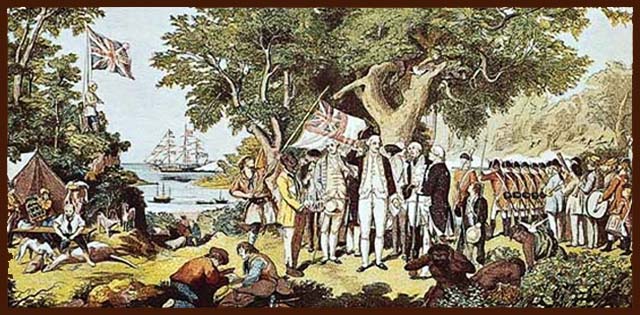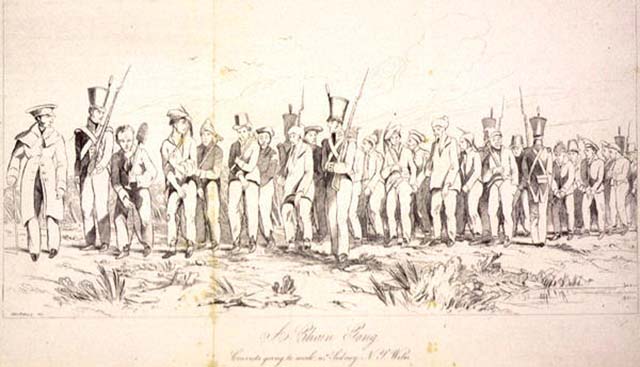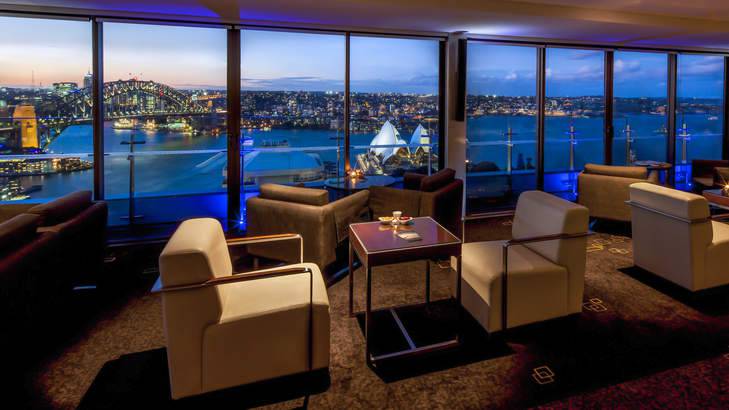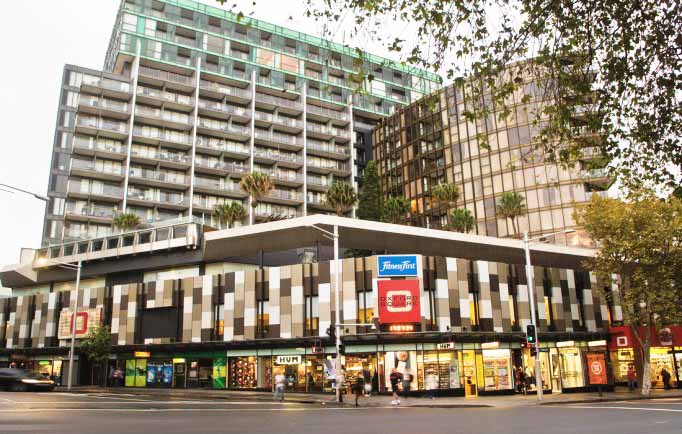
Paradoxically, but the fact that the Australian continent, on the area almost equal to the United States of America (without Alaska), was opened by Europeans after small island groups of Oceania. Though in existence of the Southern earth, or Terra Australis, still antique cartographers were sure. When Spaniards were approved in America, they excited by legends of Inca of the richest earth located in the southern part of the Great ocean began to send the ships there. A. de Mendanii’s expeditions in 1567 and 1595, P. de Kyros in 1605 opened new lands, but not the continent, but small archipelagoes: Solomonova and Marquesas Islands, New Hebrides. One of the ships of Kyros who was ordered by L. de Torres on the way back under the influence of monsoons deviated to the southwest and, having bypassed the Great Barrier Reef, passed through the passage separating New Guinea from Australia and called subsequently by his name. But not the Spaniards or Portuguese dominating for the 15-16th centuries on the Pacific Ocean, but Dutches approached the Australian continent the first of Europeans. There was it at the beginning of the XVII century. By this time Dutches and British did away with sea colonial prevalence of Portugal and Spain including on the Pacific Ocean. By the beginning of the 70th years of the 16th century in hands of Portugal from all Asian colonies there were Goa, Daman and Diu in India and Macau in China. The power of Spain in Southeast Asia and Oceania extended only to Philippines and the islands of Micronesia by then. In 1595 the first Dutch expedition to India as a part of four vessels was organized. Dutches lost a half of the ships and the third part of crews, but were convinced that it is possible to reach coast of India. In 1598 the second expedition (seven vessels) went to India. It went over with great success: all ships came back with rich freight of spices. The same year Dutches were fixed on Java Island, created trade trading stations there, leaning on which they gradually monopolized trade with the countries Southern and Southeast Asia, and also the Far East. In 1601 40 Dutch ships went to India already. Having convinced of profitability of such enterprises, the Dutch merchants in March, 1602 created society on trade with India — the Netherlands East Indian trading company. The company acquired such rights and privileges that it became some kind of state in the state. She not only exclusively traded with India, but also had the right to appoint officials to this country, to wage war and to make the peace, to mint a coin, to build the cities and fortresses, to form colonies. The capital of the company was huge on scales of that time. If the British East Indian company began the activity in 1600 with the capital of 72 thousand f. the Art. that 864 thousand equaled. guldens, the capital of the Netherlands East Indian company made 6,6 million guldens. From the first steps of the activity the Netherlands East Indian company vigorously was engaged in searches of the Southern earth. One of the ships of the company conducted by the captain V. Yanszon rounded New Guinea from the South and reached the coast of Australia at the peninsula called now Cape York peninsula. The sailors put ashore in search of water and food were killed by locals. Yanszon hurried to leave from these inhospitable coast and in June, 1606 returned to Batavia (the modern name — Jakarta). The logbook of the expedition directed by V. Yanszon did not remain. It is obvious that the message of the captain on the open earth was not inspiring. In books of the East Indian company there is short, but very expressive record: “Nothing good can be made there”. In the next half-centuries this phrase repeated heads of the company more than once. The Dutch seamen began to go to the possession in Southeast Asia of a bit different way, than Portuguese and Spaniards whose ships floated from the Cape of Good Hope along coast of Africa to the equator, and then already on the East. Dutches chose shorter route. In 1611 the captain of X. Brouer, having passed 4 thousand miles to the east from the Cape of Good Hope, then turned on the North that reduced transition time from Holland to Batavia since eighteen months to six.
The management of the East Indian company in Amsterdam officially approved this course for the ships. It helped Dutches to find the Southern continent and to investigate its western and northwest coasts. Reviews of the Dutch seamen of the new earth were discouraging.
In 1623 the Dutch ship under Ya. Karstents’s command, having repeated Yanszon’s route, entered the big gulf on the northern coast of Australia. Karstents called it the Gulf Gulf of Carpentaria, in honor of the governor general of the Netherlands East Indies of that time P. de Carpenter. In the report on swimming the captain wrote: “We did not see any fructifying tree, anything of that kind that the person could use for himself … Inhabitants — pathetic and poor beings …” [89, page 26].
In 1636 A. Van Dimen who sought for expansion of the Netherlands possession in the Southern seas became the governor general of Batavia. His commitment and persistence were very much appreciated and encouraged with the management of the Netherlands East Indian company. On September 16, 1638 the board of directors of the company was written by Van Dimenu: “Your favor works wisely, paying much attention to opening of the Southern earth and gold-bearing islands which would be very useful to the company”. By order of Wang Dimenga two ships under command of the captain A. Tasman in August, 1642 left Batavia and went to investigate “the part of the globe which remained the unknown” [67, page 67].
Floating on the southeast from the island of Mauritius, expedition reached the unknown island which received the name of Earth Wang Dimenga (the modern name — Tasmania). Continuing swimming, Tasman approached coast of New Zealand. It took it for the Southern continent. The next year Tasman investigated northern part of the Australian continent, but did not find anything attractive to the East Indian company, first of all gold and silver there. As a result the company lost interest in further researches of the Southern seas.
Englishman U. Dampir was the following European who visited coast of Australia or as then spoke, New Holland.
In the second half of the 17th century in three sea wars (1652-1654; 1665-1667; 1672-1674) England inflicted over Holland crushing defeats, having reduced it to position of the minor European country. Having become the powerful trade and sea power of the world, England is strongly approved also on the Pacific arena.
In January, 1688 U. Dampir reached coast of Australia and was three months there. Next year it was again sent to the Southern continent. This time Dampir investigated northwest part of the continent, but the lack of drinking water forced Dampir to interrupt work and to turn the ship to the island of Timor.
If Europeans, in effect, knew nothing about Tasman’s swimmings as the Netherlands East Indian company tried to keep them in secret, believing that in the future the lands opened for them can be necessary for Dutches, then Dampir’s expeditions to coast of New Holland became widely known because the English seafarer wrote two books: “New swimming round the world” and “Swimming to New Holland”. Both of them made great success and were repeatedly republished. “Residents of this country — Dampir in the book “New Swimming Round the World” wrote — the most unfortunate people on the earth … they have no houses, clothes … cattle and fruits of the earth … and, resembling human beings superficially, a little in what differ from animals” [103, page 312-313].
The foundation of the British colonization in the Southern seas was laid by J. Cook’s travel.
In opening by British of east coast of Australia and, by the way, New Zealand, strangely enough it will sound, a certain role was played by the planet Venus. The matter is that, a pas to calculations of astronomers, on June 3, 1769 Venus had to pass by a solar disk. For the best supervision over the planet the London royal society of assistance to development of natural sciences asked the British government to send group of astronomers to the Southern seas. Having been refused, society addressed directly the king who approved this plan. J. Cook who just came back from Newfoundland was appointed the head of expedition. This person not only was a skilled seaman, but also possessed knowledge of mathematics and astronomy.
The decision of the king to send the warship to the Pacific Ocean was dictated at all not by desire to give pleasure to astronomers. It became clear to Cook when he on August 26, 1768, being onboard the ship floating across the Thames to Plymouth opened carefully sealed package from the admiralty. “There is basis to believe — it was said in the order — that the continent or the earth of the huge sizes is to the South from the way passed recently by the captain Wallice by the ship of its majesty “Dolphin” or from ways of any other, earlier seamen … Therefore to you in pursuance of will of its majesty it is ordered to leave in swimming … at once upon termination of supervision over Venus and to be guided by the following instructions. To carry out opening of the continent mentioned above, you have to go to the South, will not reach width 40 ° yet and if, having made it, you do not open it … searches to the West, between the width mentioned earlier and the width of 35 ° have to continue that, you will not find it yet or will not meet East side of the earth opened by Tasman and called now New Zealand” [67, page 93-94].
The admiralty ordered further: to investigate coast of New Zealand, to make the map of islands, to study minerals, the soil, animal and flora, to collect samples of seeds and fruits, and also to declare the earth possession of the British king, having achieved on that a consent of local population and in case it does not appear to leave “visible signs and inscriptions as pioneers and owners” [67, page 94].
On April 13, 1769 Cook arrived to Tahiti, and astronomical observations over Venus were successfully made on June 3. Then Cook, carrying out instructions of the admiralty, the ship on the South in search of the Southern continent led.
On October 7, 1769 N. Jung, the servant of the ship surgeon, the first saw the white cape among ocean waves. Next day the ship entered the gulf and anchored near the mouth of the small river on which coast the New Zealand city of Gisborne is located now. Locals are Maori, having a presentiment of bad, met newcomers hostilely. In the started fight several natives were killed. Cook, as well as Tasman, was convinced of courage of the Maori who were not frightened of neither muskets, nor guns of Europeans.
Despite obvious disapproval of inhabitants, Cook, scrupulously carrying out the instruction of the admiralty, strengthened on the place of the disembarkation a staff with the English flag and proclaimed New Zealand property of the British crown [67, page 98]. In March, 1770 Cook finished research of coast of New Zealand. In April its ship entered the Australian waters.
On April 19, 1770 to looks of British coast of Australia opened. “I called this place Hicks — J. Cook wrote in the diary — because the lieutenant Hicks was the first who saw this earth” [131, page 298-299]. Cook went north along the coast, did not reach the place called by it Botany Bay as the botanists who were taking part in expedition found a large number of unknown to them there before species of plants, birds and animals yet.
On April 29, 1760 sailors were put ashore. Locals showered with their hail of stones and mines, British answered with volleys from guns. “Thus — the modern Australian historian M. Clark sadly notes — the European began the tragic communication with natives of east coast” [95, t. 1, page 49]. Till May 6 J. Cook investigated areas Botany Bay, and then continued the swimming. Having left to the North from Cape York peninsula, he was convinced that the continent opened for them is separated from New Guinea by the passage. J. Cook declared it property of the British crown. Having descended on the coast of one of Torresov’s islands of the passage called Posseshen, Cook set up on it the British flag and declared that from now on the power of the British sovereign extends to all east coast of the continent from 38 ° southern latitude to the island Posseshen. At these words the sailors standing near it fired three volleys from guns; from the ship answered with shots from guns [95, page 50]. East part of Australia called by Cook New South Wales became property of the British crown.
The European seafarers, opening new lands and declaring their property the monarchs, not especially thought of an origin and history of the people inhabiting them. They just established the presence fact of the human beings standing on the development on the lowest level there. Cook looked at locals a bit different eyes. “At first, when I saw natives of New Holland — he wrote — they made on me impression of the most pathetic people on the earth; but in … reality they are much happier than Europeans because are unfamiliar not only with excesses, but also with the necessary conveniences so widespread in Europe … They live in tranquility which is not broken by a situation inequality. The earth and the sea “supply them with all necessary for life. They do not dream of magnificent houses, house servants etc.; they live in warm and fine climate and enjoy healthy air … It seems to me, they consider that they have all necessary for life” [91, page 323].
During the earliest period of the European colonization of Australia and Oceania bourgeois scientists put forward “theory” about inferiority of natives, their organic inability to progressive development which very helped with the “development” of the occupied lands connected often with mass destruction of indigenous people.
Presently the science has the data allowing to claim that lag in development of aboriginals of Australia before arrival of Europeans is explained by objective socio-historical conditions. “Complex studying of original culture of natives of Australia — the Soviet researcher V. R. Kabo writes — demonstrates that in general, despite preservation of some archaic elements, it throughout many millennia continuously developed. And though Australians … happened to endure the deep cultural crisis connected mainly with catastrophic changes of an environment, development of their culture continued, though slower rates” [50, page 53-54].
As showed archaeological opening in Southeast Asia and Australia in the 50-60th years of our century, settling of Australia began not less than 30 thousand years ago, during a Paleolithic era when the fifth continent was connected with Southeast Asia continental bridges, Asian and Australian continental shelves and passages between them were not an absolute obstacle even for the people possessing extremely primitive: navigation aids [50, page 58].
The natural and geographical conditions existing during this period favored to development and settling by people of the Australian continent, including its internal areas which turned into a zone of deserts and semi-deserts only in the period of a thermal maximum, i.e. from 7 thousand till 4 thousand years ago. Sharp change of habitat led to considerable regress of the Australian culture. It was promoted by deaf isolation of Australians from the outside world.
Arrival of Europeans not only did not promote cultural development of the Australian natives, but, on the contrary, was for them new hardest test which can be compared only to natural disaster of huge destructive force. Many thousands of natives were destroyed. Colonialists forced out aboriginals from coastal areas to deserts and by that doomed them to extinction. If to arrival of British the total number of the native population reached 300 thousand people, then two hundred years later their number does not exceed 150 thousand, including metises.
Source:
Malakhovsky K.V. ‘History of Australia’ — Moscow: Science, 1980






Leave a Reply